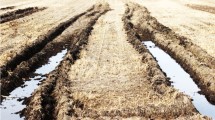Summary
Asoil is ordinarily composed in varying amounts of oil, wax, or grease; solid particles of diverse types; and special water-soluble or water-dispersible materials such as sugar, salts, starch, etc. Quantitatively the fatty portion on fabrics may run to a substantial fraction of 1% and contains roughly one-third neutral fat, one-third higher fatty acids, one-third other materials, and undetermined. Airborne dust may contain over 20% of fatty matter, over 30 per cent of other organic matter. Soil is retained on fabrics by mechanical forces, chemical forces, electrostatic attraction, and oil-bonding, which itself operates by means of electrical forces on the molecular scale.
The fundamental equations of wetting are presented. They imply that oily soils will gravitate toward the smallest capillaries in fabries and thus become increasingly difficult to remove as the soiled fabric ages. Polymerization of unsaturated oils and chemical linkage of conjugated unsaturated bonds to active sites on the fibers are also factors in the setting of soil as fabric ages.
For extremely light soiling, the darkening of the fabric is roughly proportional to the amount of soil. As degree of soiling increases, the amounts of soil needed to give proportional darkening become enormously greater. From the viewpoint of detergency this means that the difference between good and bad results depends on removal of the last traces of soil.
Similar content being viewed by others
References
Bacon, O. C., and Smith, J. E., Ind. Eng. Chem.40, 2361–70 (1948).
Brown, C. B., Research (London)1, 46–48 (1947).
British Research Assn. for the Woollen and Worsted Industries, Trans. Textile Inst.13, 127–142 (1942).
Gotte, E., and Kling, W., Kolloid-Z.64, 227–7, 327–31, 331–5 (1933).
Hall, L. P., Am. Dyestuff Reporter27, 612–16 (1938).
Harris, J. C., Textile Research Journal28, No. 11, 669–678 (1948).
Hoyt, L. F., Soap and Sanitary Chemicals24, 42–4, 59 (1948).
Harwood, F. C., and Powney, J., Chemistry and Industry1948, 579–81.
Kind, W., and Oldenroth, O., Fetter und Seifen46, 292–9 (1939).
Madsen, Thorkild, “Studies in the Detergent Action and Surface Activity of Soap Solutions,” pp. 11, 47–9, 53–4, Nordlundes Bogtrikkeri, Copenhagen, Denmark, 1930.
Osterling, J. F., Am. Dyestuff Reporter27, 617–20 (1938).
Reich, Irving, and Snell, Foster Dee, Ind. Eng. Chem.40, 1233–7, 2333–7 (1948).
Reich, Irving, and Snell, Foster Dee, Ind. Eng. Chem.41, December 1949.
Rideal, E. K., Chem. & Ind.1948, 403, 409.
Snell, Foster Dee, Chemistry and Industry1949, 539–45; Chem. Eng. New27, 2256–62.
Spring, W., Z. Chem. Ind. Kolloid4, 161–8 (1908).
Spring, W., Z. Chem. Ind. Kolloid6, 11–7, 109–11, 164–8 (1910).
Spring, W., Rec. trav. chim.28, 424–43 (1910).
Thomas, A. W., “Colloid Chemistry,” p. 336. McGraw Hill Co., Inc., N. Y., 1934.
Utermohlen, William T., Jr., and Wallace, E. Louise, Textile Research Journal17, 670–88 (1947).
Author information
Authors and Affiliations
About this article
Cite this article
Snell, F.D., Snell, C.T. & Reich, I. The nature of soil to be deterged and its bonding to the surface. J Am Oil Chem Soc 27, 62–68 (1950). https://doi.org/10.1007/BF02634882
Received:
Issue Date:
DOI: https://doi.org/10.1007/BF02634882




